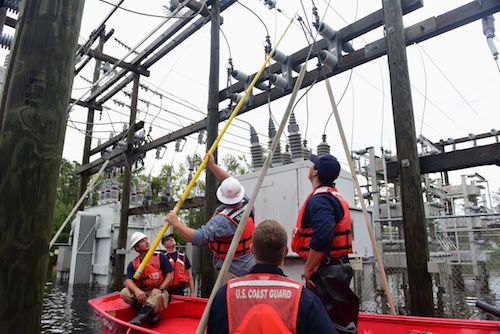Even before Hurricane Florence made landfall last Friday,
thousands of IBEW members from more than 17 states and parts of Canada had
already been mobilized and were making their way toward the storm’s projected route,
ready to repair damage the storm was expected to leave behind.

|
U.S. Coast Guard shallow-water response team members escort electric utility employees to a flooded Newport, N.C., transformer substation on Sept. 16.
Photo provided under a Flickr/Creative Commons agreement by Coast Guard News.
|
“As with every natural disaster, we hope for the best, but we prepare for the worst,” said International President Lonnie R. Stephenson. “Our highly-trained members are first responders in the truest sense, bringing with them the tools and know-how needed to help restore power — and some sense of normality — in affected areas as quickly and as safely as possible.”
Tens of thousands of residents along the Carolinas’ coast had already evacuated by the time Florence landed on Wrightsville Beach near Wilmington, N.C., early Friday morning as a 400-mile-wide Category 1 storm.
Even though Florence had weakened into a slow-moving tropical storm, more than half a million customers in its path lost electricity thanks to its damaging winds and torrential downpours; before the weekend was out, as many as 1 million customers had reported power cuts.
“Our IBEW brothers and sisters definitely have their work cut out for them,” said Utility Department Director Donnie Colston.
Crews worked around the clock — and continue to do so — assisting the various public and investor-owned electric companies and cooperatives throughout the region to get customers reconnected to the power grid. By Monday, the number of customers still in the dark had been slashed by nearly half.
“That’s a good start,” Colston said, “but our members will stick with it until power gets restored to every affected home and business.”
Florence wound up dumping as much as 30 inches of rain on some parts of the Carolinas. Sadly, at least 33 people were killed as a direct result of the storm, which moved north as a tropical depression through portions of Tennessee, Virginia, and the Ohio River valley before eventually turning east and heading toward New England's Atlantic coast by mid-week.
Flooding and toppled trees remain ongoing concerns for linemen and tree-trimmers, potentially threatening their efforts to reach and repair downed power lines and fallen utility poles.
“Even so, our men and women will continue to work safely and rely on their training to assess damage and get power restored as quickly as possible,” Colston said.
You may donate money to help people affected by Hurricane Florence at redcross.org, governor.nc.gov, or yourfoundation.org.